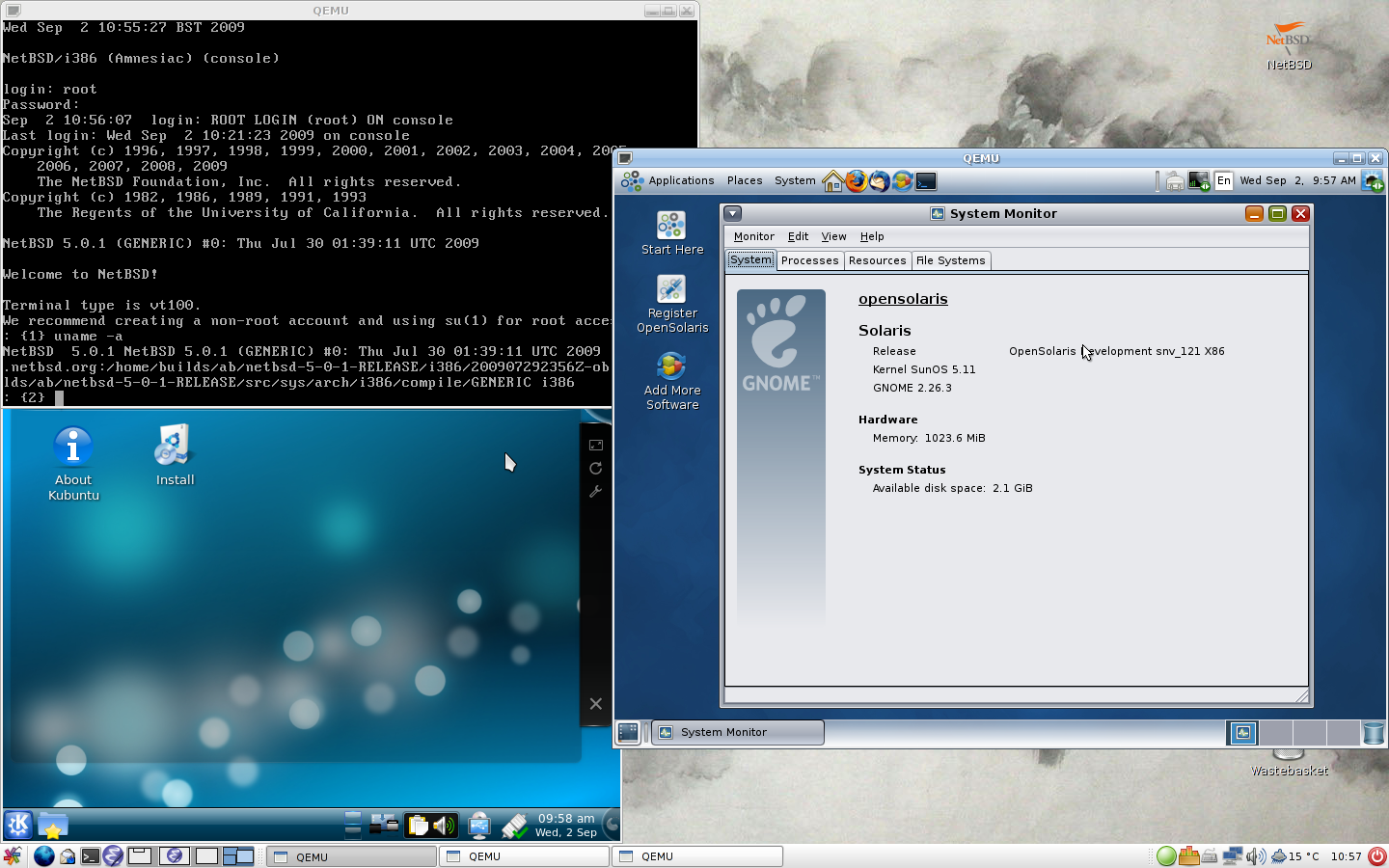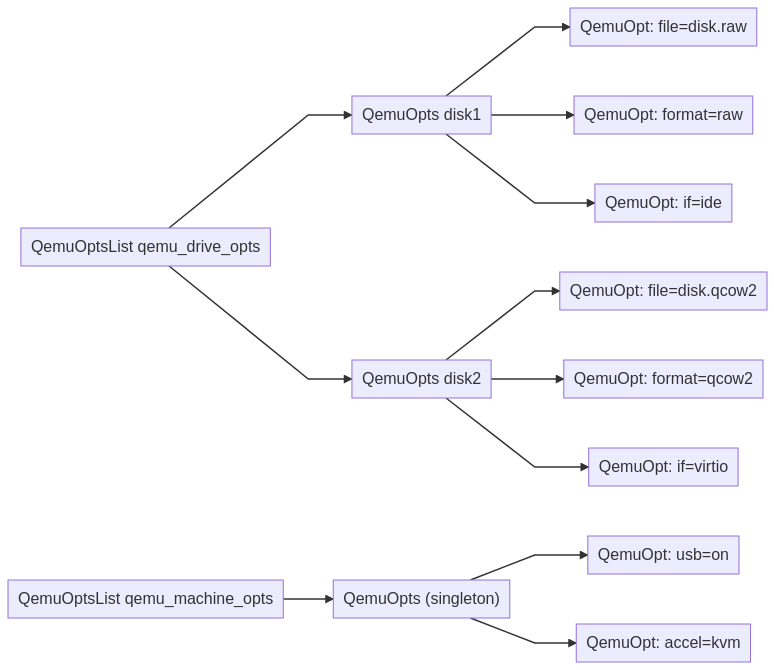Today when people refer to KVM hypervisor, they actually mean the QEMU-KVM combination. The developers of KVM took advantage of QEMU architecture and basically created a new model of CPU in QEMU. This new model type has KVM specific logic. When execution of a code can run natively (meaning CPU opcode that does not require IO). QEMU is a free and open-source emulator that performs hardware virtualization. QEMU is a hosted virtual machine monitor: it emulates the machine's processor through dynamic binary translation and provides a set of different hardware and device models for the machine, enabling it to run a variety of guest operating systems. It also can be used with KVM to run virtual machines at near-native speed. QEMU can also do emulation for user-level processes, allowing applications compiled for one architec. I am using qemu-system-x8664 to boot virtual machines on kvm running on Ubuntu 12.04 64-bit desktop. I have a few VM's that are currently running. I want to get the list of all VM's booted using q. QEMU ARM guest support. The reason we support so many is that ARM hardware is much more widely varying than x86 hardware. ARM CPUs are generally built into 'system-on-chip' (SoC) designs created by many different companies with different devices, and these SoCs are then built into machines which can vary still further even if they use the same SoC. The Transport Layer is decided by the machine type. Currently the machines n800 and n810 have one HCI and all other machines have none. Note: This option and the whole bluetooth subsystem is considered as deprecated. If you still use it, please send a mail to qemu-devel@nongnu.org where you describe your usecase. The following three types are recognized:-bt hci,null.
Still trying to get GPU passthrough working and decided to change machine type from older 440fx to q35 ie pc-q35 but if I do virsh edit on the config it refuse to save saying 'PCI Bridges not supported'.. by current qemu binary. What do I need to fix/change in the virtual machine xml file?
After some research seems q35 only allows PCIexpress PCIe and not PCI but I don't know what to change in my xml file so that virsh stops complaining and accepts change from 440fx to q35.
This is on Debian Jessie: uname -aLinux vmserver 3.16.0-customvmkernel #1 SMP Sun Sep 28 00:34:42 PDT 2014 x86_64 GNU/Linux
kvm --versionQEMU emulator version 2.1.0 (Debian 2.1+dfsg-4)
Here is my current virtual machine file with 440fx that I want to change to q35:
Tiff editor free download - Advanced TIFF Editor, Multi-Page TIFF Editor, Advanced TIFF Editor Plus, and many more programs. Advanced TIFF Editor is a program for editing TIFF and other image files. It is also aiming at helping users viewing, converting, annotating and printing images. This utility is available in several languages. Multi-Page TIFF Editor is comprehensive and effective solution to view, edit, annotate and print your multipage TIFF files (faxes, business papers etc.). This program has everything you need to work with multipage TIFF documents - from common operations with pages in multipage TIFF documents. Tiff editor software. Advanced TIFF Editor (TIFF Editor for multipage files) is a FAX, TIFF (TIF), PDF, DCX, EPS, PS, AI, GIF, J B IG and DICOM viewer, editor and converter, offers you a full solution for viewing, editing, printing, drawing, saving, converting. Program allows to view or edit multi-page TIFF, PDF, DCX, EPS, PS files. Editing includes: adding or removing pages, changing page order, inserting of new pages from scanner. Multi-Page TIFF Editor (MPTE) is a complete solution for viewing, editing, creating and converting multipage TIFF files. This program can be useful for viewing or editing scanned documents (faxes, business papers etc.) - it is an absolutely necessary tool to work with documents in TIFF format.
htfreehtfree4 Answers
I just did this today - pretty much as 'Fox' described, except change the pci controller entry instead of deleting it - changing 'pci-root' to 'pcie-root'
Then it will complain about anything with a bus-related parameter - I think you can leave the item but remove the specification. I also had to remove USB-related entries (piix3 integrated controller requires a PCI bus, or something to that effect).
Not sure if you're still trying to do this - but I tought I'd put it out there for anyone else who searches for this.
There is a patch available for the underlying issue (being that QEMU won't allow you to bind to a PCIe root bus, which is needed for Windows guests on Q35):

Latest virt-manager (1.1.0) supports setting architecture on VM creation. You can not change it later.
With virsh edit, I am guessing a little, but I would try removing the PCI controller and all bus related parameters (like <address />. And changing
<type arch='i686' machine='pc-i440fx-2.1'>hvm</type>
to
<type arch='i686' machine='pc-q35'>hvm</type>
Normally i'd offer this in a comment, since its more of a guess, but it's too long. I'll remove it if it does not work.
btw. those <qemu:arg /> at the end might be causing trouble as well. If you run into problems, try removing those as well.
Try instead of pc-i440fx-2.1 above
See an example at https://gist.github.com/lyarbean/7036986
I'd run qemu manually with -M q35 or -M ? to check the version you have installed really supports it
hth
Not the answer you're looking for? Browse other questions tagged virtualizationvirtual-machineskvm-virtualizationlibvirtqemu or ask your own question.
I have an Openstack Pike deployment in Cloudlab, and it is using QEMU version 2.10.1(Debian 1:2.10+dfsg-0ubuntu3.8~cloud1).
I wanted to replace the QEMU with this version which enables support for monitoring through QMP. I configured using : ./configure --target-list=x86_64-softmmu and compiled the binary qemu-system-x86_64 but when I check the supported machine types it was missing some of the machine types which were present in the original binary:
Qemu Machine Type E
So when I tried to deploy a test VM with Openstack, it gave me the error:
and when I changed the machine type to one of the available ones hw_machine_type = x86_64=pc-i440fx-1.6 , it gave me this error:
So after looking around for the error I just created a symlink:
But then it gives the following error:
So I am thinking that maybe I should just use the original machine type, and I want to know how do we add more supported machine types when building QEMU? I guess it must be one of the configuration options but I haven't been able to find it.
WajahatWajahat1 Answer
Adding new machine types is done by modifying the QEMU source code when building it. As you might guess from the machine names, these are specific to the Ubuntu QEMU version, so they will have been added via patches in the Ubuntu QEMU package. The machines will basically be like the stock upstream pc-i440fx-n.n and pc-q32-n.n ones, but will have properties set so that they behave 'like the version of QEMU that shipped in this release of Ubuntu'. This is important for compatibility when migrating virtual machines. It may also have minor differences like what BIOS blob filenames it looks for: Ubuntu/Debian might also have patched QEMU to edit things like the directory searched for BIOS blobs.
The other QEMU version you link to is based on upstream QEMU, so it doesn't have those Ubuntu specific patches that enable the Ubuntu specific machine types. (It's also based on an older version of QEMU so will be missing various fixes for security issues discovered after that release, so be cautious! Check whether any of the non-patched security issues between 2.8.1 and now are important for your use case.)
You can either press forward with trying to adjust your machine configuration to work with the non-Ubuntu machine type. (Use the most recent pc-i440fx-n.n it has -- 1.6 is pretty elderly and it ought to have a 2.8.) Or alternatively you can try to rebase the patches that add the QMP-monitoring feature so that they apply to the Ubuntu QEMU sources. For anything resembling production I think the latter is probably the way to go because of the no-security-fixes problem with using somebody's random development tree, but it may not be easy.
Peter Maydell Peter Maydell
Peter Maydell